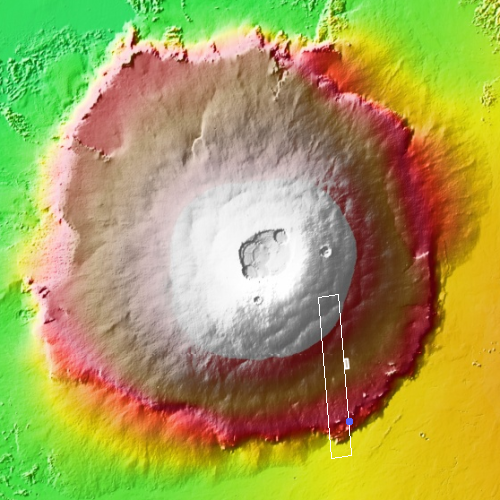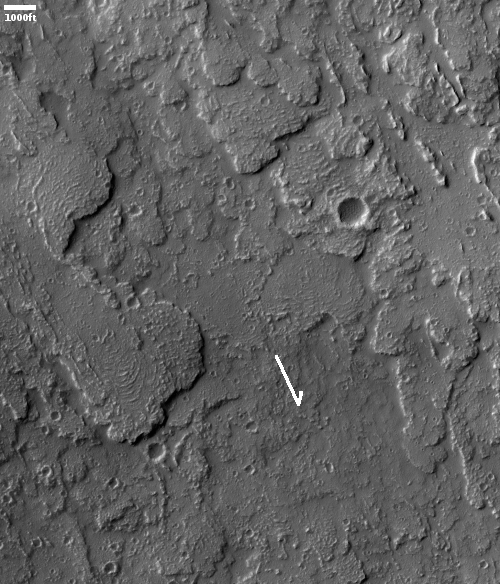The gigantic lava flows off of the solar system’s biggest known volcano
Cool image time! The photo to the right, cropped, reduced, and annotated to post here, was taken on October 30, 2021 by the high resolution camera on Mars Reconnaissance Orbiter (MRO). The picture covers a very tiny section of the southeast flank of Olympus Mons, the largest known volcano in the solar system. The arrow indicates the direction of the downward slope.
Olympus Mons itself is about 400 miles wide with an actual height relative to Mars’ “sea level” of just under 70,000 feet, more than twice as high as Mount Everest on Earth. The mountain’s flanks, almost 200 miles long from caldera edge to base, drop about 54,000 feet. That average drop of about 270 feet every mile is not particular steep, but its continuous nature over such a very very long distance makes its quite daunting.
You can see evidence of that slope in the photo. The downward pointing lobes each indicate the volcano’s last separate lava flows that ceased moving when each froze in place, probably several tens of millions of years ago. These lobes were also placed on top of many earlier flows from the volcano’s past eruptions that probably continued for several billion years, beginning 3.5 billion years ago.
The overview map helps provide a sense of scale by placing this image on that mountain flank.

The white rectangular box shows the area covered by today’s full image. The larger white rectangle is the area covered by an December 18, 2016 image taken by MRO’s context camera. The blue dot near the bottom of that large rectangle marks the location of an earlier cool image, posted in May 2021, showing the volcano’s now frozen lava flow as it begins its precipitous drop off that flank.
Make sure you look at the full image as well as that December 18 context camera image. The extent of this flow is amazing. Its age, relatively young for Mars, can be roughly measured by the number of craters on this surface. The low number of craters suggest this surface is only a few million years old.
The large extent of Olympus Mons lava flanks is also another indication that lava flows farther and faster in Mars’ low gravity than it does on Earth.
On Christmas Eve 1968 three Americans became the first humans to visit another world. What they did to celebrate was unexpected and profound, and will be remembered throughout all human history. Genesis: the Story of Apollo 8, Robert Zimmerman's classic history of humanity's first journey to another world, tells that story, and it is now available as both an ebook and an audiobook, both with a foreword by Valerie Anders and a new introduction by Robert Zimmerman.
The ebook is available everywhere for $5.99 (before discount) at amazon, or direct from my ebook publisher, ebookit. If you buy it from ebookit you don't support the big tech companies and the author gets a bigger cut much sooner.
The audiobook is also available at all these vendors, and is also free with a 30-day trial membership to Audible.
"Not simply about one mission, [Genesis] is also the history of America's quest for the moon... Zimmerman has done a masterful job of tying disparate events together into a solid account of one of America's greatest human triumphs."--San Antonio Express-News
Cool image time! The photo to the right, cropped, reduced, and annotated to post here, was taken on October 30, 2021 by the high resolution camera on Mars Reconnaissance Orbiter (MRO). The picture covers a very tiny section of the southeast flank of Olympus Mons, the largest known volcano in the solar system. The arrow indicates the direction of the downward slope.
Olympus Mons itself is about 400 miles wide with an actual height relative to Mars’ “sea level” of just under 70,000 feet, more than twice as high as Mount Everest on Earth. The mountain’s flanks, almost 200 miles long from caldera edge to base, drop about 54,000 feet. That average drop of about 270 feet every mile is not particular steep, but its continuous nature over such a very very long distance makes its quite daunting.
You can see evidence of that slope in the photo. The downward pointing lobes each indicate the volcano’s last separate lava flows that ceased moving when each froze in place, probably several tens of millions of years ago. These lobes were also placed on top of many earlier flows from the volcano’s past eruptions that probably continued for several billion years, beginning 3.5 billion years ago.
The overview map helps provide a sense of scale by placing this image on that mountain flank.

The white rectangular box shows the area covered by today’s full image. The larger white rectangle is the area covered by an December 18, 2016 image taken by MRO’s context camera. The blue dot near the bottom of that large rectangle marks the location of an earlier cool image, posted in May 2021, showing the volcano’s now frozen lava flow as it begins its precipitous drop off that flank.
Make sure you look at the full image as well as that December 18 context camera image. The extent of this flow is amazing. Its age, relatively young for Mars, can be roughly measured by the number of craters on this surface. The low number of craters suggest this surface is only a few million years old.
The large extent of Olympus Mons lava flanks is also another indication that lava flows farther and faster in Mars’ low gravity than it does on Earth.
On Christmas Eve 1968 three Americans became the first humans to visit another world. What they did to celebrate was unexpected and profound, and will be remembered throughout all human history. Genesis: the Story of Apollo 8, Robert Zimmerman's classic history of humanity's first journey to another world, tells that story, and it is now available as both an ebook and an audiobook, both with a foreword by Valerie Anders and a new introduction by Robert Zimmerman.
The ebook is available everywhere for $5.99 (before discount) at amazon, or direct from my ebook publisher, ebookit. If you buy it from ebookit you don't support the big tech companies and the author gets a bigger cut much sooner.
The audiobook is also available at all these vendors, and is also free with a 30-day trial membership to Audible.
"Not simply about one mission, [Genesis] is also the history of America's quest for the moon... Zimmerman has done a masterful job of tying disparate events together into a solid account of one of America's greatest human triumphs."--San Antonio Express-News



“That average drop of about 270 feet every mile is not particular steep, . . .”
Works out to about a 5% grade. That is very respectable, especially if you want to move something up it.
Blair Ivey: On Earth a 5% grade might be hearty, but in Mars’ 38% gravity it is more equivalent to a 2% grade.